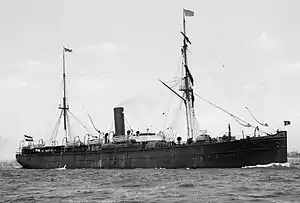Suevia (ship)
The Suevia was a passenger steamship built for the Hamburg America Line in 1874. It was assigned to transatlantic crossings between Hamburg, Germany and New York City, USA and played a role in German immigration to the United States.
 Suevia | |
| History | |
|---|---|
| Name: | Suevia |
| Owner: | Hamburg America Line |
| Operator: | Hamburg America Line |
| Builder: | Caird & Co., Greenock, Scotland |
| Completed: | 1 June 1874 |
| Commissioned: | 21 October 1874 |
| Recommissioned: | 1896 |
| Decommissioned: | 1898 |
| Fate: | Collided with Commodore Bateman 1889; scrapped 1898 |
| Notes: | Operated commercially as passenger ship for the Hamburg America Line 1874-1894. |
| General characteristics | |
| Type: | Passenger ship |
| Tonnage: | 3,609 Gross register tons |
| Length: | 360.3 ft (109.8 m) |
| Beam: | 41 ft (12 m) |
| Propulsion: | Steam |
| Speed: | 13 knots |
| Complement: | 115 |
The Suevia had accommodation for 100 first-class, 70 second-class and 600 third-class passengers. It had two masts and reached a speed of 13 knots. In 1884 it got new steam boilers and served for the Hamburg America Line 10 more years until 1894. In 1896 it was sold to Schiaffino, Nyer & Siges in Algeria and renamed Quatre Amis. After it stranded near Antwerp[1] in 1898 it was scrapped in Marseille.
Collision
On 13 April 1889 the Suevia collided in dense fog near Nantucket with the US pilot boat Commodore Bateman which therefore sank and two persons died. The Commodore Bateman was just launched in 1888.[2]
See also
- Carl Eytel – a German-American artist who immigrated to the United States aboard the Suevia in 1885.[3]
References
- http://www.norwayheritage.com/p_ship.asp?sh=suev1
- https://timesmachine.nytimes.com/timesmachine/1888/07/19/106328619.pdf
- German Immigrants, 1880s: Carl Eytel from Wurtemberg to Kansas in 1885 arrived: 11-04-1885; occupation: hunter; destination: Kansas; native country: Wurtemberg; native city: Machingen; embarkation port: Hamburg; manifest number: 38415.